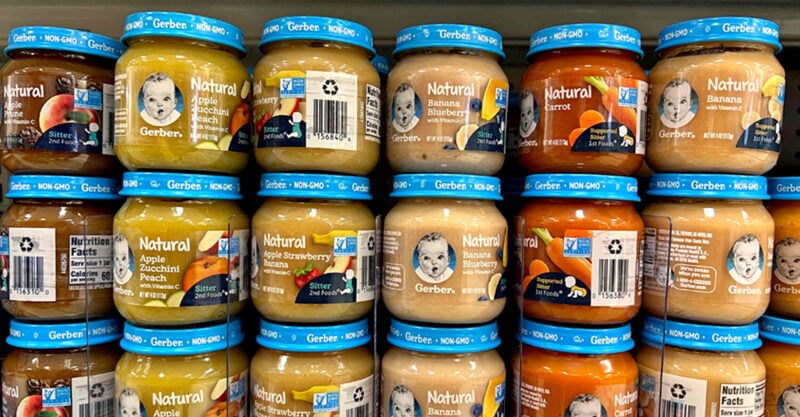Miss a day, miss a lot. Subscribe to The Defender's Top News of the Day. It's free.
The U.S. Food and Drug Administration (FDA) on Tuesday released new draft guidance proposing limits on lead in processed baby food and on foods — including dry cereals, mashed fruits and root vegetables — intended for children under age 2.
The new guidance comes after multiple studies revealed that many processed foods for young children contain levels of lead “known to pose a risk of neurological and developmental impairment,” The New York Times reported.
The FDA said the proposed guidelines would “help reduce potential health effects in this vulnerable population from dietary exposure to lead” and “would result in significant reductions in exposures to lead from food while ensuring availability of nutritious foods.”
The proposed limits may reduce exposure to lead in such products by up to 27%, Reuters reported.
However, many nutritional experts questioned the FDA’s new proposals, arguing that no level of lead in foods is safe and that the rules do not cover other heavy metals or foods for the general population.
Critics also argued the guidance will be non-binding for industry and not all food products will be covered by these guidelines.
A 2019 study that tested 168 baby food products from 61 brands — including Gerber, Parent’s Choice, Up&Up, Enfamil and Similac — found 95% were contaminated with at least one heavy metal. Other studies reported similar findings.
According to the Centers for Disease Control and Prevention, there is no safe level of lead for children.
‘An overdue step in the right direction’
The FDA’s draft guidance, “Action Levels for Lead in Food Intended for Babies and Young Children,” covers processed foods packaged in “jars, pouches, tubes and boxes and intended for babies and young children less than two years old.”
It sets the following limits:
- 10 parts per billion (ppb) for fruits, vegetables (excluding single-ingredient root vegetables), mixtures (including grain and meat-based mixtures), yogurts, custards, puddings and single-ingredient meats.
- 20 ppb for root vegetables (single ingredient).
- 20 ppb for dry cereals.
Lead exposure in these three categories of food products would be reduced by 26%, 27% and 24%, respectively, CNBC reported.
Pedram Esfandiary, a Los Angeles-based attorney who previously litigated cases involving heavy metal content in baby foods and their potential connection to autism spectrum disorder and attention-deficit/hyperactivity disorder, called the proposed guidelines “an overdue step in the right direction.”
Esfandiary told The Defender:
“The FDA’s announcement is an overdue step in the right direction. As the agency acknowledges, there is no safe level of lead exposure when it comes to babies’ health, and even low levels of contamination in baby food products can cause significant, lasting injuries to children’s neurodevelopment.
“Given that this is a draft guidance, we encourage the agency to finalize an even lower action limit. It is way past due that baby food manufacturers — some of which have demonstrated nothing short of willful negligence — are held to meaningful, enforceable standards when it comes to these dangerous toxins in food pandered to our most vulnerable population.”
Scott Faber, senior vice president of government affairs for the Environmental Working Group, praised the FDA’s proposed guidelines. “This is really important progress for babies,” Faber told the Times. “We were grateful that FDA and the Biden administration has made reducing toxic metals in baby food a priority.”
Tom Neltner, senior director for safer chemicals at the Environmental Defense Fund, told Consumer Reports the proposed guidelines are stricter than those in Europe, and he told USA Today the limits are “the most protective in the world.”
But, he added, “I think we could go lower,” but this would require improved lab-testing capabilities.
Guidelines aren’t mandatory and don’t cover all baby foods
The FDA’s proposed limits apply only to lead, although Consumer Reports detected the presence of other heavy metals, such as arsenic, cadmium and mercury, in baby food products.
And the limits aren’t mandatory, but instead “should be viewed only as recommendations, unless specific regulatory or statutory requirements are cited,” the agency said.
However, the FDA also said it “intend[s] to consider these action levels, in addition to other factors, such as our confidence in a measured analytical value, when considering whether to bring enforcement action in a particular case” against food manufacturers.
The proposed guidelines do not cover all baby food products — the new rules “do not address grain-based snacks that have also been found to contain high levels of heavy metals,” the Times reported.
Such food products include rice-based puffs and teething puffs, for which “the FDA is seeking additional information on levels for those foods,” according to USA Today.
Neltner said such foods also are high in lead and other heavy metals and should also require similar limits.
“It may have been they weren’t sure how much of a biscuit a kid actually eats, or the contribution to the diet may be small,” Neltner told USA Today.
Guidelines don’t ‘go far enough to protect babies from neurodevelopmental damage’
Jane Houlihan, research director for Healthy Babies Bright Futures, told the Times the FDA’s plan “doesn’t go far enough to protect babies from neurodevelopmental damage from lead exposures,” adding that “the action levels that FDA has set will influence almost none of that food” and “codify the status quo.”
Tracey Woodruff, Ph.D., a scientist at the University of California, San Francisco, who studies toxin exposure, told the Times, “Corporations are innovative and know how to tweak what they need to meet legal standards and make a profit.”
Rep. Raja Krishnamoorthi (D-Ill.), who released a report in 2021 finding many baby food products were contaminated with heavy metals, told the Times the FDA’s new limits aren’t as strict as legislation that he and other makers introduced in March 2021.
Brian Ronholm, director of food policy at Consumer Reports, said, “It appears the proposed standards were based more on current industry feasibility to achieve the limits, and not solely on the levels that would be optimal for protecting public health.”
Ronholm said that the proposed limits “represent an encouraging first step,” but more clearly needs to be done to limit exposure to lead and protect babies and young children. “There is no safe level of lead exposure, so manufacturers have to be even more aggressive in reducing the amount of lead in their baby foods,” he said.
He also called on the FDA to “take action on setting strict limits on so-called baby junk food — grain-based snacks such as puffs, rusks, and wafers.”
In determining the new guidelines, the FDA said it “considered, among other factors, the level of lead that could be in a food without dietary exposure exceeding the FDA’s Interim Reference Level, a measure of the contribution of lead in food to blood lead levels.”
“Just as fruits, vegetables and grain crops readily absorb vital nutrients from the environment, these foods also take up contaminants, like lead, that can be harmful to health,” the FDA said. “The presence of a contaminant, however, does not mean the food is unsafe to eat.”
The agency said it “evaluates the level of the contaminant in the food and exposure based on consumption to determine if the food is a potential health risk.”
According to the FDA:
“Although it is not possible to remove these elements entirely from the food supply, we expect that the recommended action levels will cause manufacturers to implement agricultural and processing measures to lower lead levels in their food products below the proposed action levels, thus reducing the potential harmful effects associated with dietary lead exposures.”
Susan Mayne, Ph.D., director of the FDA’s Center for Food Safety and Applied Nutrition, advised parents not to rely on the agency’s draft guidance alone. She said:
“The action levels in today’s draft guidance are not intended to direct consumers in making food choices. To support child growth and development, we recommend parents and caregivers feed children a varied and nutrient-dense diet across and within the main food groups of vegetables, fruits, grains, dairy and protein foods.
“This approach helps your children get important nutrients and may reduce potential harmful effects from exposure to contaminants from foods that take up contaminants from the environment.”
FDA should have published lead limits ‘almost a year ago’
In 2021, the FDA launched its “Closer to Zero” initiative, which, according to CNBC, aims “to reduce the levels of lead, arsenic, cadmium and mercury in children’s food and which, according to Consumer Reports, “set the agency’s timeline for proposing limits on heavy metals in baby food.”
These include arsenic, lead and mercury.
However, Consumer Reports noted that “according to that schedule, lead limits should have been out almost a year ago.”
The FDA claims that “the agency’s work to date has resulted in significant progress in reducing exposure to environmental contaminants from foods and Closer to Zero builds on this progress,” with a focus on research and analysis, regulation and consultation.
Notably though, despite limits set by the FDA in August 2020 on the amount of inorganic arsenic that could be present in infant rice cereal, tests conducted several months later by Consumer Reports found that arsenic remained present in such foods.
In April 2022, the FDA also proposed draft guidance setting lead limits in juices.
However, while such draft guidelines are applicable to food for babies and young children, Consumer Reports stated:
“Currently, the FDA has no limits on the amount of lead allowed in foods, except for a recommended maximum level of 100 ppb in candy likely to be consumed frequently by young children.
“The Environmental Protection Agency also has a limit of 15 ppb lead in public drinking water and 5 ppb in bottled water.”
According to the FDA though, the agency has “prioritized foods commonly eaten by babies and young children because their smaller body sizes and metabolism make them more vulnerable to the harmful effects of these contaminants.”
A public comment period for the FDA’s draft guidelines on lead in baby food is now open, with a submission deadline of March 27, while the FDA states it will soon organize a webinar “to provide an overview of the draft guidance and answer stakeholder questions.”





